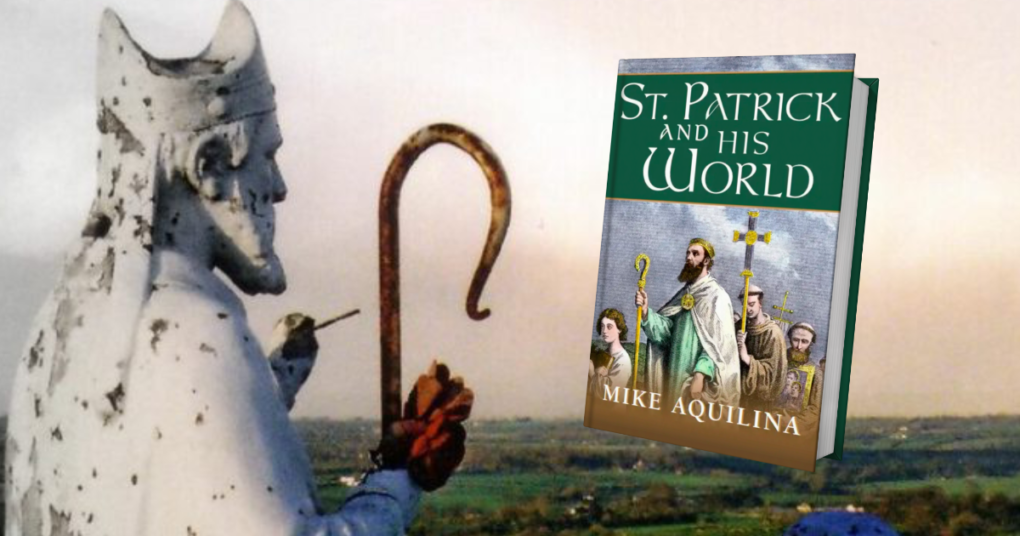St Patrick and his World
Mike Aqulina
Scepter
Jan. 2024
144 pages
ISBN:978-1594175046
It might be said that a review of a book on St Patrick should hardly be appearing in June or July since March is the time when people’s thoughts turn to our national saint. But do they? The majority’s thoughts nowadays turn in the Spring towards celebrations, perfectly legitimate in themselves. However, the sight of people dressed up in robes they think St Patrick might have worn, whether in parades or at sporting occasions like the Cheltenham Festival or rugby matches (even if Ireland are winning the Triple Crown or a Grand Slam) does nothing for the Patrick writing this review, who dislikes the sight of such caricatures and would love to know the real St Patrick better.
So now that the next feast of the saint is more than nine months away, it is a good time to delve into a little book written in USA by a man with an Italian sounding name, who was inspired to write it during the pandemic when, on reading a doctoral dissertation by Fr William Swan on Patrick, became convinced the St Patrick should be numbered among the Fathers of the Church.
Aquilina goes straight into facts and myths. Both the evidence of Pliny the Elder and of modern paleontologists tell us that even hundreds of years before Patrick there were no snakes in Ireland; that myth only started about the year 1200! Most of the facts we do know come from his writings: the Confession and the Letter to the Soldiers of Coroticus. The Confession was written by Patrick in defence against false accusations, and the Letter was written in justifiable anger at the slaughter of some of Patrick’s followers by a British warlord.
Throughout the book Aquilina points to the difficulties Patrick’s lack of detail on dates in the Confession causes for historians – apparently he worked on the assumption that his readers knew the details already. Patrick’s writing also lacked style – he even apologised for his poor Latin – but his deficiency in this area is more than made up for with the authenticity of what he wrote.
Having given an outline of what we do know of Patrick’s life, Aquilina goes on to look behind the bare facts. He devotes a full chapter to Roman Britain where Patrick grew up, ostensibly a Christian, and another to the situation of Ireland which was known about but regarded as literally “the end of the earth”. Notwithstanding that, there was obviously trade between Britain and Ireland and wherever there was trade, people moved and brought their beliefs with them. So even before Patrick there were Christians in Ireland.
The well known story of his Patrick’s capture, enslavement and later escape is well chronicled, with particular attention given to his blossoming prayer life. Likewise his gradual realisation that God was calling him to a mission in Ireland and his journey there are spelt out in some detail. Chapter Seven describes the Creed of St Patrick – in many ways similar to the Nicene Creed – and the seven sections of his Lorica or breastplate (Lúireach Pádraig) of which most of us would only be familiar with the last part beginning with “Christ with me, Christ before me…”. He needed the support from on high for his many potentially deadly encounters with petty kings and other adversaries.
Most of the myths and legends about St Patrick come from his biographer Muirchú who wrote in the eighth century, in other words more than two hundred years after Patrick’s death. Aquilina retells some of these and some of them are quite extraordinary, for example the story of Patrick’s supposed journey to his former slave master Miliucc to pay the price of his redemption and the latter’s being driven by the devil to burn down his own house with himself in it rather than meet the saint. There are others too – Aquilina suggest they are unlikely but possibly true.
On the other hand, most of the actual details Aquilina presents are taken from the Confession and the Letter, and a lot of them were unknown to me and, I suspect, are unknown to many of Patrick’s spiritual children. All in all, the book is true to its title St Patrick and his World, and should be read by all those fascinated by the real saint who really did convert this land to Christianity over 1,500 years ago and to whom we owe it not to let that heritage be lost.
About the Author: Pat Hanratty
Pat Hanratty taught Science/Chemistry in Tallaght Community School from its inception in 1972 until he retired in 2010. He was the school’s first Transition Year Co-ordinator and for four years he had the role of Home School Community Liaison Officer.

